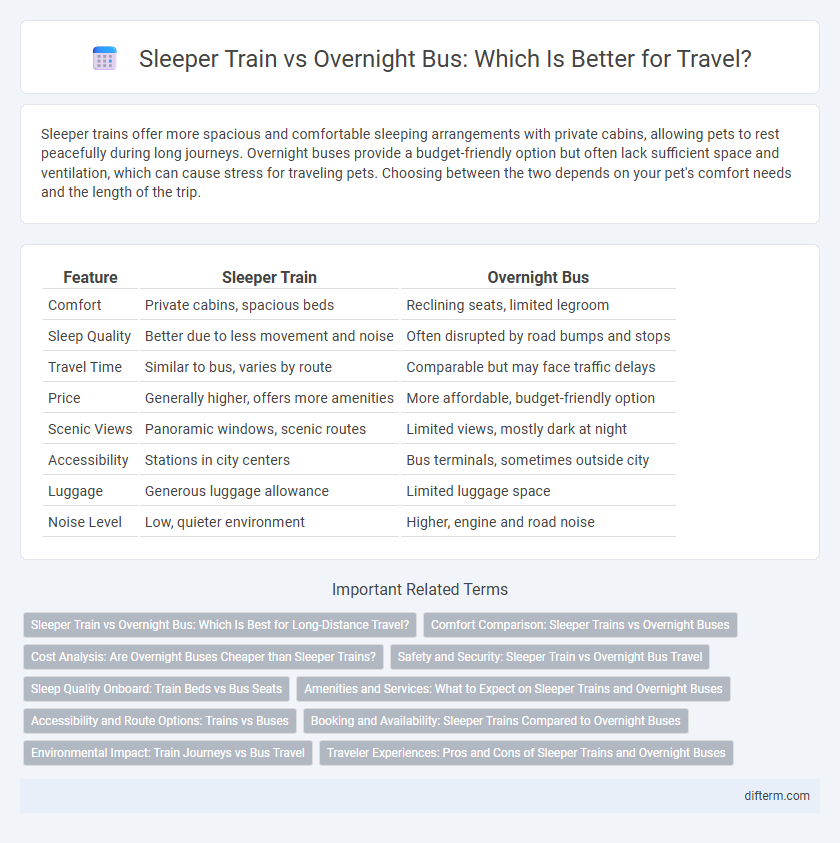Sleeper trains offer more spacious and comfortable sleeping arrangements with private cabins, allowing pets to rest peacefully during long journeys. Overnight buses provide a budget-friendly option but often lack sufficient space and ventilation, which can cause stress for traveling pets. Choosing between the two depends on your pet's comfort needs and the length of the trip.
Table of Comparison
| Feature | Sleeper Train | Overnight Bus |
|---|---|---|
| Comfort | Private cabins, spacious beds | Reclining seats, limited legroom |
| Sleep Quality | Better due to less movement and noise | Often disrupted by road bumps and stops |
| Travel Time | Similar to bus, varies by route | Comparable but may face traffic delays |
| Price | Generally higher, offers more amenities | More affordable, budget-friendly option |
| Scenic Views | Panoramic windows, scenic routes | Limited views, mostly dark at night |
| Accessibility | Stations in city centers | Bus terminals, sometimes outside city |
| Luggage | Generous luggage allowance | Limited luggage space |
| Noise Level | Low, quieter environment | Higher, engine and road noise |
Sleeper Train vs Overnight Bus: Which Is Best for Long-Distance Travel?
Sleeper trains offer spacious sleeping compartments, more legroom, and quieter environments compared to overnight buses, making them ideal for restful long-distance travel. In contrast, overnight buses are generally more affordable and offer frequent routes, but often lack the comfort and privacy of sleeper trains. Travelers prioritizing comfort and stable sleep are better served by sleeper trains, while budget-conscious passengers may opt for overnight buses despite potential trade-offs in comfort.
Comfort Comparison: Sleeper Trains vs Overnight Buses
Sleeper trains offer spacious compartments with reclining seats or private cabins, providing travelers with better rest and privacy compared to overnight buses, which typically have narrower, less cushioned seats and limited legroom. Noise and vibration levels on sleeper trains are generally lower due to smoother rails, enhancing overall comfort for long journeys. Traveling by sleeper train also allows for walking and access to onboard amenities like dining cars, which are rarely available on buses, further improving passenger comfort.
Cost Analysis: Are Overnight Buses Cheaper than Sleeper Trains?
Overnight buses generally offer lower ticket prices compared to sleeper trains, making them a budget-friendly option for cost-conscious travelers. Sleeper trains, while more expensive, provide added comfort, privacy, and amenities that justify the higher fare for many passengers. Evaluating the cost difference involves considering additional expenses such as booking fees, onboard services, and the potential value of a more restful journey.
Safety and Security: Sleeper Train vs Overnight Bus Travel
Sleeper trains generally provide enhanced safety features such as locked compartments, onboard security staff, and surveillance cameras, reducing risks compared to overnight buses, which often lack these security measures. Passengers on sleeper trains benefit from monitored environments and restricted access areas, minimizing exposure to theft or harassment. Overnight buses may face greater vulnerability due to frequent stops, crowded conditions, and limited security presence, impacting overall traveler safety.
Sleep Quality Onboard: Train Beds vs Bus Seats
Sleeper trains offer spacious, cushioned beds designed for extended rest, significantly enhancing sleep quality compared to the limited reclining and padding available on overnight bus seats. The stable, smooth motion of trains reduces disturbances, allowing travelers to experience deeper, uninterrupted sleep, whereas buses often encounter more jolts and road noise. Bedding on sleeper trains, including blankets and pillows, further contributes to comfort, making them the preferred option for those prioritizing restful overnight travel.
Amenities and Services: What to Expect on Sleeper Trains and Overnight Buses
Sleeper trains typically offer spacious cabins with beds, privacy curtains, and sometimes even en-suite washrooms, enhancing comfort during long journeys. Overnight buses usually provide reclining seats, limited legroom, and basic amenities such as USB charging ports and onboard restrooms. Passengers on sleeper trains can expect meal services and attentive staff, while bus travelers often rely on scheduled stops for food and bathroom breaks.
Accessibility and Route Options: Trains vs Buses
Sleeper trains offer superior accessibility with spacious cabins and onboard amenities designed for comfort during overnight travel, while buses often have limited legroom and fewer accessibility features. Train routes typically cover major cities with multiple stop options, providing diverse travel itineraries, whereas overnight buses primarily serve less central locations with fewer route variations. The extensive rail networks facilitate seamless connections and better integration with other transport modes compared to bus routes, enhancing overall travel convenience.
Booking and Availability: Sleeper Trains Compared to Overnight Buses
Sleeper trains typically offer more advanced booking options with seat and cabin selection available weeks or months in advance, ensuring greater availability for travelers seeking comfort. Overnight buses often have a more limited reservation system, with seats allocated on a first-come, first-served basis and fewer opportunities for early booking. Passengers prioritizing guaranteed availability and specific seating arrangements generally find sleeper trains to be a more reliable choice for secure reservations.
Environmental Impact: Train Journeys vs Bus Travel
Sleeper trains typically produce lower carbon emissions per passenger kilometer compared to overnight buses, making them a more eco-friendly travel option. Trains run on electricity, which increasingly comes from renewable sources, while most buses rely on diesel engines that emit higher levels of greenhouse gases. Choosing sleeper trains helps reduce air pollution and supports sustainable transportation initiatives in the travel industry.
Traveler Experiences: Pros and Cons of Sleeper Trains and Overnight Buses
Sleeper trains offer spacious cabins and the comfort of a bed, allowing travelers to rest better during long journeys, while overnight buses are often more affordable but come with limited legroom and less privacy. Trains typically provide smoother rides with onboard amenities such as dining cars and washrooms, enhancing the overall experience compared to the basic facilities found on buses. Travelers who prioritize comfort and reliability may opt for sleeper trains, whereas budget-conscious passengers looking for flexibility might prefer overnight buses despite potential fatigue.
Sleeper Train vs Overnight Bus Infographic

 difterm.com
difterm.com